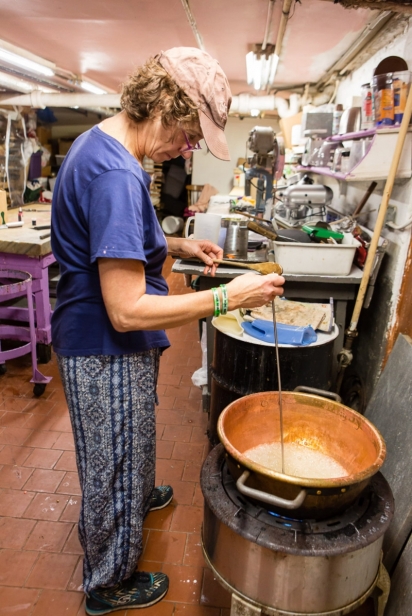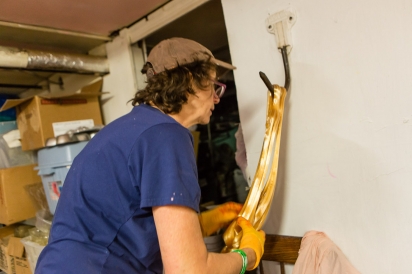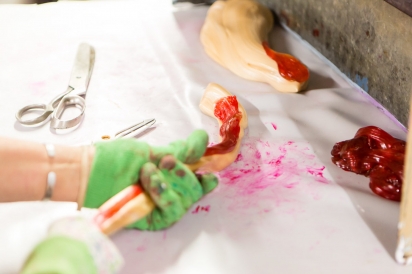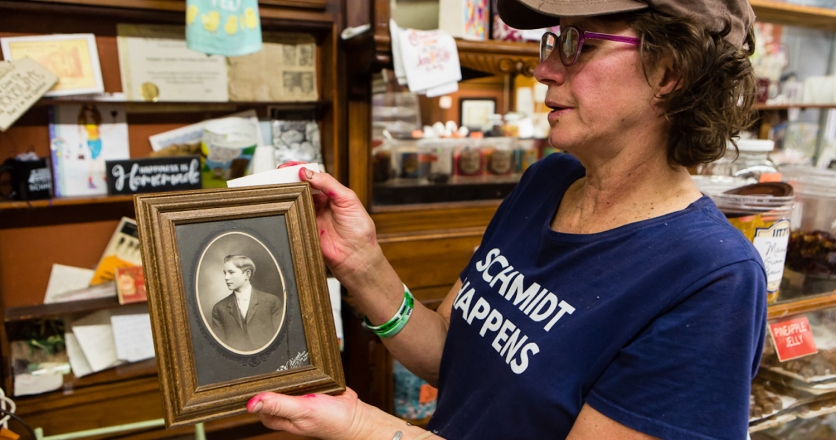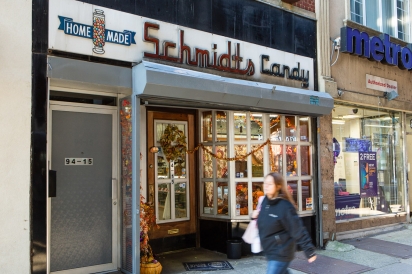Schmidt’s Candy Has Been Making Hand-Pulled Candy Canes for Nearly 90 Years
Margie Schmidt has extremely strong arms. She’s 60 years old, and recently had foot surgery; she takes summers off, when she enjoys holidays to Ireland, and dozes off in her sunny backyard. But from October through March or April, she’s a force, working 12-hour days (sometimes overnight) pulling batches of sugar-and-water globs, cutting and shaping fresh candy canes on the original marble slab inside the Schmidt’s Candy store on Jamaica Avenue in Woodhaven.
Schmidt was 27 when she took over the candy business her grandfather started in 1925, or 1926, or 1927—no one’s sure exactly what year—when he immigrated to Queens from Germany. She’d already been through college and earned her master’s; her father wanted her to be a pharmacist and join a union, but things didn’t go that way. Organic chemistry did her in. When her father died at 64, Schmidt became the candymaker. Ever since, she’s been crafting the confections in solitude inside the old-fashioned ice cream parlor. She’s lost sensation in her fingertips now, but she’ll never forget the first time she made lemon drops from molten hot syrup cooked at 320° “that could burn you and put you down.”
The six words Schmidt would use to describe herself? “Thanksgiving, Christmas, Valentine’s, Easter, sleep, repeat,” she says. “That’s it. My favorite day of the year is the day after Easter.”
Did Schmidt mention she hates Christmas? Ah, but it’s when she does some of her best business, selling the classic candy canes; ribbon candy; nonpareils with the red, green and white sprinkles; chocolate-dipped caramels; chocolates made from molds; and specialty hard candies. Sure, you can find a better deal on these products elsewhere, but $6 for a dozen of Schmidt’s handmade, hand-pulled peppermint canes is a steal for all the labor that’s involved. As Schmidt says, “Every piece of candy in that showcase goes through my 10 digits.”
To make the candy canes, she cooks sugar and water and real peppermint oil that costs $90 a bottle and then pulls the mixture back and forth on an old-fashioned meat hook, the way the Jersey Shore machines do it with taffy, except Schmidt is the machine.
“Those are my arms pulling it back and forth, so I have to be strong. I have to be feeling good.”
The more she pulls, the more aerated the glob gets; the oxygen turns it white. There’s no taking breaks, because the minute you stop working the viscousness, it firms, resulting in broken sticks. So when she gets bored, or her shoulder hurts, she pulls the glob out to make pieces, snaking into smaller snakes. Once she’s pulled the size of a stick, she cuts it and throws a ‘J.’
Hers don’t look uniform or perfect; each piece is unique. That means—don’t expect flawless red lines. The stripes get added in under a small heater—to keep the concoction pliable—so the dyed amber bleeds as it’s pulled and incorporated into the mix, and the candy canes can end up pink. “If you want uniformity, you buy from the supermarket,” Schmidt says. “If you want it tasty, you want mine.”
Schmidt has seen a generation of loyal old-timers come and go but new regulars have sprung up in their place. Still, business is slow. Where once there were two-hour waits, Schmidt says these days her bottom line is such that her sister refers to the business as her “hobby.” In Grandpa Schmidt’s day, there were at least 25 candy shops on Jamaica Avenue. Now there are at least 20 empty storefronts, and more beauty salons than anything else.
She wishes she had the money to hire part-time help. None of her three children is interested in taking over the family business, and no one else knows how to make the candy.
“I’m pretty sure it dies with me, but that’s the way it is.” The recipes are barely written down in a black and white notebook. And then, there’s the fear that sharing those half-scribbled recipes with an apprentice could lead to usurpation—making the candy on their own to pack in pretty boxes, shipped off to new customers.
So for now, it’s just Schmidt, same as it’s always been. She got her strong work ethic from her father, who she barely knew because he worked 363 days a year, a cigar hanging out the side of his mouth while he made the caramels (“I don’t know where those ashes went…”). But she’s made different choices. She deliberately didn’t learn how to make the 17% butterfat handmade ice cream that her father sold, because it would have meant staying open through summer, and Schmidt didn’t want to live like that.
Once Schmidt arrives in October and starts decorating the front window, like clockwork, people start poking their heads inside—“Are you open yet?”
Of course, they’re not just coming for the candy, delicious though it may be. Schmidt knows people come to see her hold court. They want to be entertained; they want a story, and Schmidt always has one. She’s an extrovert and she’s happy to oblige, but people always want something from her, so that’s why even Queen Margie (as she refers to herself on her voicemail greeting) has to escape from the thrum now and then, sometimes working in the dark so nobody will bother her, and keeping the gate pulled down on Sundays and Mondays so she can work in peace. And if God would grant her the strength, she’d love to work for another 10 years.




